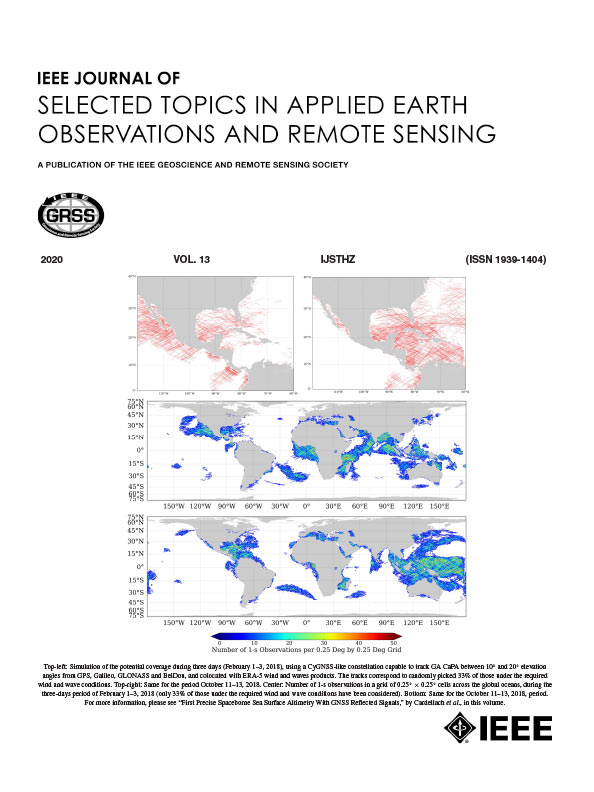Cloud Removal Advances: A Comprehensive Review and Analysis for Optical Remote Sensing Images
IF 5.3
2区 地球科学
Q1 ENGINEERING, ELECTRICAL & ELECTRONIC
IEEE Journal of Selected Topics in Applied Earth Observations and Remote Sensing
Pub Date : 2025-06-18
DOI:10.1109/JSTARS.2025.3580718
引用次数: 0
Abstract
Cloud cover significantly decreases the quality of optical remote sensing (ORS) images, adversely impacting its effectiveness in geographic monitoring, disaster prevention, and advanced visual applications. This phenomenon has made cloud removal a critical preprocessing step in ORS image processing. This article comprehensively reviews cloud removal techniques and classifies them based on the type of auxiliary data used: single-image, multimodal, and multitemporal. The discussed methods include physical modeling, deep learning, multispectral analysis, and synthetic aperture radar (SAR) fusion strategies. This article analyzes the core concepts and fundamental processes of these techniques and addresses the challenges encountered in actual scenarios. The article also includes future research directions. Moreover, the article outlines the benchmark datasets and evaluation metrics commonly used in cloud removal, thereby establishing a standardized reference for algorithm development and performance evaluation. A thorough comparative analysis was performed to assess their performance variations using visualization outcomes from the most recent and representative methodologies.云去除进展:光学遥感图像的综合综述与分析
云层显著降低了光学遥感(ORS)图像的质量,对其在地理监测、灾害预防和高级视觉应用中的有效性产生不利影响。这种现象使得去云成为ORS图像处理中一个关键的预处理步骤。本文全面回顾了云去除技术,并根据使用的辅助数据类型对它们进行了分类:单图像、多模态和多时间。讨论的方法包括物理建模、深度学习、多光谱分析和合成孔径雷达(SAR)融合策略。本文分析了这些技术的核心概念和基本过程,并解决了在实际场景中遇到的挑战。文章还对未来的研究方向进行了展望。此外,本文还概述了云移除中常用的基准数据集和评估指标,从而为算法开发和性能评估建立了标准化参考。通过使用最新和最具代表性的方法的可视化结果,进行了全面的比较分析,以评估他们的性能变化。
本文章由计算机程序翻译,如有差异,请以英文原文为准。
求助全文
约1分钟内获得全文
求助全文
来源期刊
CiteScore
9.30
自引率
10.90%
发文量
563
审稿时长
4.7 months
期刊介绍:
The IEEE Journal of Selected Topics in Applied Earth Observations and Remote Sensing addresses the growing field of applications in Earth observations and remote sensing, and also provides a venue for the rapidly expanding special issues that are being sponsored by the IEEE Geosciences and Remote Sensing Society. The journal draws upon the experience of the highly successful “IEEE Transactions on Geoscience and Remote Sensing” and provide a complementary medium for the wide range of topics in applied earth observations. The ‘Applications’ areas encompasses the societal benefit areas of the Global Earth Observations Systems of Systems (GEOSS) program. Through deliberations over two years, ministers from 50 countries agreed to identify nine areas where Earth observation could positively impact the quality of life and health of their respective countries. Some of these are areas not traditionally addressed in the IEEE context. These include biodiversity, health and climate. Yet it is the skill sets of IEEE members, in areas such as observations, communications, computers, signal processing, standards and ocean engineering, that form the technical underpinnings of GEOSS. Thus, the Journal attracts a broad range of interests that serves both present members in new ways and expands the IEEE visibility into new areas.

 求助内容:
求助内容: 应助结果提醒方式:
应助结果提醒方式:


